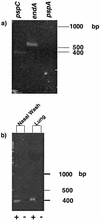Role of pneumococcal surface protein C in nasopharyngeal carriage and pneumonia and its ability to elicit protection against carriage of Streptococcus pneumoniae
- PMID: 11953392
- PMCID: PMC127914
- DOI: 10.1128/IAI.70.5.2526-2534.2002
Role of pneumococcal surface protein C in nasopharyngeal carriage and pneumonia and its ability to elicit protection against carriage of Streptococcus pneumoniae
Abstract
Previous studies suggested that PspC is important in adherence and colonization within the nasopharynx. In this study, we conducted mutational studies to further identify the role PspC plays in the pathogenesis of pneumococci. pspC and/or pspA was insertionally inactivated in a serotype 2 Streptococcus pneumoniae strain and in a serotype 19 S. pneumoniae strain. In the mouse colonization model, pneumococcal strains with mutations in pspC were significantly attenuated in their abilities to colonize. In a mouse pneumonia model, strains with mutations in pspC were unable to infect or multiply within the lung. Using reverse transcriptase PCR we were able to demonstrate that pspC is actively transcribed in vivo, when the bacteria are growing in the nasal cavity and in the lungs. In the bacteremia model, a strain mutated for pspC alone behaved like the wild type, but the absence of both pspC and pspA caused accelerated clearance of the bacteria. Intranasal immunization with PspC with cholera toxin subunit B as an adjuvant protected against intranasal challenge. Evidence was also obtained that revertants that spontaneously acquired PspC expression could multiply and colonize the nasal tissue. This latter finding strongly indicates that pneumococci are actively metabolizing and growing while in the nasopharynx.
Figures






References
-
- Achen, M. G., B. E. Davidson, and A. J. Hillier. 1986. Construction of plasmid vectors for the detection of streptococcal promoters. Gene 45:45-49. - PubMed
Publication types
MeSH terms
Substances
Grants and funding
LinkOut - more resources
Full Text Sources
Other Literature Sources
Medical

